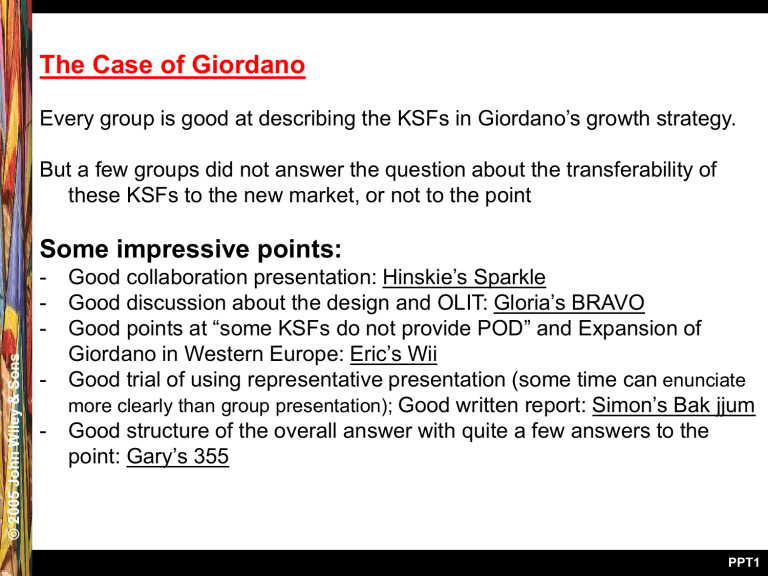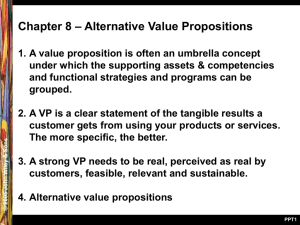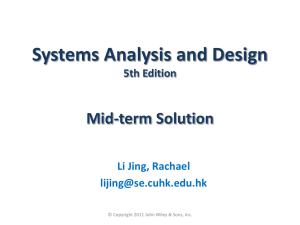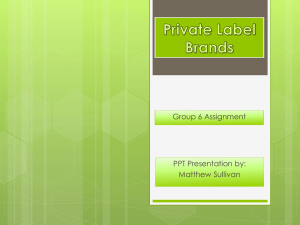Strategic Market Manangement - 7th Edition

The Case of Giordano
Every group is good at describing the KSFs in Giordano’s growth strategy.
But a few groups did not answer the question about the transferability of these KSFs to the new market, or not to the point
Some impressive points:
Good collaboration presentation: Hinskie’s Sparkle
Good discussion about the design and OLIT: Gloria’s BRAVO
Good points at “some KSFs do not provide POD” and Expansion of
Giordano in Western Europe: Eric’s Wii
Good trial of using representative presentation (some time can enunciate more clearly than group presentation); Good written report: Simon’s Bak jjum
Good structure of the overall answer with quite a few answers to the point: Gary’s 355
PPT1
The Case of Giordano
Performance evaluation: what I gave you higher than what you gave your peers
Flora’s Group “355”
Hinskie’s Group “Sparkle”
Simon’s Group “Bak jjum”
Gloria’s Group “BRAVO”
Eric’s Group “Wii”
2.96
2.72
3.44
3.30
2.57
PPT2
Chapter 14 Setting Priorities for Businesses & Brands
Identifying the business units that are priorities (not priorities) is a key to a successful strategy.
- Priorities: Invest/Grow strategies (chapter10-13)
- Not priorities: Exit/Milk/Hold strategies
1. Business Portfolio
BCG growth-share portfolio model
- GE business position-market attractiveness model
2. An Exit Strategy – Divestment or Liquidation
Motivations
- When to Exit
- Exit Barriers & Biases
3. A Milking Strategy
4. The Brand Portfolio – Brand Consolidation Process
PPT3
1. The Business Portfolio
Portfolio: a collection of investments held by an institution
BCG matrix – Market growth rate vs. Market share
(1) Star – Most important to the business and deserving of any needed investment
(4 growth strategies)
(2) Cash Cows – The source of cash, generating cash flow by reducing investment and operating expenses to a minimum (Milk strategy)
(3) Dogs – Potential cash traps & candidates for liquidation (Exit strategy)
(4) Problem Children (Question Marks) – Have heavy cash needs but will eventually convert into starts (Selective investment strategy)
GE matrix – Market attractiveness vs. Business position
An expansion of the BCG matrix
The advantage is that the dimensions are more comprehensive and detailed
Market attractiveness: a composite measure of the potential for sales and profits in a particular market segment
Business position : the strength of our offering relative to other companies’ products
To invest/grow; To use selective investment; To harvest/divest
PPT4
2. An Exit Strategy (Divestment or Liquidation)
Motivations
(1) A resource drain (not profitable given the investment required)
(2) Not fit with strategic direction (a distraction to the internal culture and the external brand image)
When to exit
(1) Business position (weak)
(2) Market attractiveness (no demand, high price pressure)
(3) Strategic fit (not fit with strategic direction)
Exit Barriers
Termination costs
Impact on the reputation & operation of other company businesses
Exit Biases
(1) Reluctance to give up (e.g., emotional attachment)
(2) Confirmation bias (lead to not objectively evaluate the business)
PPT5
For Discussion
Jack Welch, during his first 4 years as GE’s CEO, divested 117 business units accounting for 20 percent of the corporation’s assets.
What are some of the motivations that led to these divestments?
PPT6
For Discussion
Jack Welch demanded that all business units be one or two in their market.
To leave industries with weak prospects and enter those with better ones.
PPT7
3. A Milk Strategy
A milk or harvest strategy
(1) Minimize (reduce) the expenditures toward the business
(2) Maximize the short-term cash flow
A hold strategy (a variation of milking) – Super for cash cows
(1) Avoid growth-motivated investment
(2) Employ an adequate level of investment to maintain a market position e.g.,
Miller and Bud ( 百威啤酒 )have been milked while resources have gone to Miller Lite and Bud Light;
Kodak for a long time has milked its film business
PPT8
4. The Brand Portfolio
The logic is to categorize brands so that precious brand-building budgets are allocated wisely.
One element of brand strategy is to set priorities within brand portfolio, identifying
(1) The strong strategic brands ( with equity, supporting a sig. business )
(2) Other brand playing worthwhile roles ( supporting a niche or local business )
(3) Brands that should receive no investment ( cash cows )
(4) Brands that should be deleted ( no equity, no potential )
5-step Brand Consolidation Process
(1) Identify the relevant brand set
(2) Brand Assessment
(3) Prioritize the Brands
(4) Develop the revised portfolio strategy
(5) Design and implement the migration strategy
PPT9
4. The Brand Portfolio
For Discussion
How would you determine if a firm has too many brands?
PPT10
4. The Brand Portfolio
For Discussion
How would you determine if a firm has too many brands?
See all P&G’s brands http://www.pg.com/common/product_sitemap.jhtml
You need to determine if every brand has a role that merits investment.
Brands that are basically taking on a descriptive role but are absorbing resources are candidates for downsizing or eliminating.
The brand consolidation process will provide an objective way to evaluate brands.
PPT11
4. The Brand Portfolio
For Discussion
What in your judgment are the key problems or issues in the brand consolidation process?
5-step Brand Consolidation Process
Identify the relevant brand set
Brand Assessment
Prioritize the Brands
Develop the revised portfolio strategy
Design and implement the migration strategy
PPT12
4. The Brand Portfolio
For Discussion
What in your judgment are the key problems or issues in the brand consolidation process?
(1) There are problems in assessing all the brands
Each dimension involves subjectivity: e.g., differentiation, relevance, growth prospects, extendibility and business fit all involve judgment calls.
(2) The determination of the roles
Involves not only strategic judgment but also organizational sensitivities and either a high level of persuasion or power.
(3) Developing the final portfolio and implementing it can be formidable problems.
PPT13
Chapter 15 Organizational Issues
Applying the concepts to specific organizations
Consider several organizations such as:
A professional sports team like the Houston Rocket
A university such as Lingnan
A products company such as GE
A service company such as Bank of East Asia
Four key organizational components:
Structure; System; People; Culture
Main ideas of this chapter:
- A strategy must match with the structure, systems, people and culture of the organization;
- Each organizational component needs to fit with the others;
- If an inconsistency exists, implementation of the strategy will be affected.
PPT14
Chapter 15 Organizational Issues
1. Structure
- defines the lines of authority and communication
- can vary in the degree of centralization
Centralization:
- Maximizes the chances that synergy opportunities will be exploited
- Resources will be allocated wisely
- Cross silo brands can be managed with consistency
- A central brand identity is helpful not only in external communication but also in building a culture
Decentralization: managers are empowered and motivated to innovate, are close to the market and can therefore understand customer needs e.g., GE and Nike have elements of centralization and decentralization:
Facilitative/Consultative/Service provider model is the best course, maybe on a permanent bases.
PPT15
Chapter 15 Organizational Issues
1. Structure (Cont)
- can vary in the formality of communication channels
Functional Structure (silo structure):
Structured according to functional areas
- Silo structure is with high walls built around the departments
- No ability or desire to go between the department
Matrix Structure
Structured according to product lines
- A cross-functional project team, e.g., CFT (Customer Focused Team)
- Utilizes department representatives/agents to connect functional areas to the customers
- Formalize communication between the departments
PPT16
Chapter 15 Organizational Issues
2. Systems
Several management systems are strategically relevant and can influence strategy implementation
1. Information System: providing customer insights, competitive intelligence, and trend analysis, driving innovation and strategy creation and adaptation
2. Measurement & Reward System: drive behavior and thus directly affect strategy implementation; Key measures to evaluate performance (motivate employees to cooperate, communicate and create synergy, reflecting long term perspective)
3. Planning System: A planning template plus creative, out-of-box thinking
PPT17
Chapter 15 Organizational Issues
3. People
- What type of people are needed to make the organization run effectively? What leadership or skill characteristics are most critical?
Strategies require certain types of people:
Functional areas, such as marketing, manufacturing, operations, and finance
- Product or market areas
- New product programs
- Management of particular types of people, a particular type of operation & growth and change
Sourcing:
Insiders: conversant with its culture & systems, have established networks, a
proven track record; too comfortable with the status quo
Outsiders: needed functional expertise, experience, and credibility; don’t know the organization
PPT18
GE’s Jack Welch believes that people are the most important ingredient to success. What are the implications of that belief?
Implications are that the company spends a lot of time and resources on
(1) People evaluation (GE has several meeting during the year on this for top executives)
(2) People training (GE sets the standard for training, Jack Welch spent a night with each class)
(3) Hiring (GE looks for smart, loyal, trustworthy people who share the common vision and goals of the company)
(4) Firing (Welch is famous for his controversial policy of firing the bottom ten percent)
PPT19
Chapter 15 Organizational Issues
4. Culture - Involves three elements
Shared Values
specify what is important
- widely accepted
Norms of Behavior
informal rules that influence decisions and actions throughout an organization;
- suggest what is appropriate and what is not;
- norms encourage behavior consistent with shared values
Symbols and Symbolic Action (c ultures are largely developed & maintained by the use of consistent, visible symbols & symbolic action)
- The founder & original mission (e.g., personality of Richard in Virgin)
- Modern role models help communicate values
- Activities, questions asked routinely, rituals
PPT20
For Discussion
Assume that you are CEO of a company like Leapfrog, which sells entertaining, electronic-based learning devices for customers ranging from infants to high school students.
Describe the culture you would like to develop and maintain.
PPT21
For Discussion
The two dominating values should be education and an electronic game technology culture.
The company should also be one that
- Is fun
- Is intuitive
- Is a learning organization
- Is family oriented
- Consists of risk takers
- Has a strong desire to nurture the next generation
PPT22
Hit Industries e.g., Three different types of firms that compete in hit industries
Hit Industries the goal is to obtain, produce, and exploit a product that will have a relatively short life cycle, e.g., movies, records, fashion, publishing, video games, computer software…
Organizational problems are intense and graphic
PPT23
What are the differences between hit industry roles (an oil industry analogy)?
Drillers – find new ideas/products fast
People: product development people
Structure: flat, loose, no structure
Culture: risk taking, creative, high-energy
System: high bottom-line performance incentives
Pumpers – produce the products/service
People: production control people
Structure: centralized, tight control
Culture: risk-averse, cost oriented, discipline
System: no bottom-line performance incentives
Distributors – marketing & distribution
People: marketing and distribution people
Structure: decentralized, loose control
Culture: promotion oriented
System: some bottom-line performance incentives
An organization starts as a drilling company, then takes the form of either a pumper or a distributor after establishing some products. The 4 components change accordingly.
PPT24
How can a new corporate chief marketing officer (CMO) get traction?
Eight approaches
Get the CEO on Board
Get the right people
Cross-silo teams
Get easy wins
Be facilitator/consultant
Engage the business units
Deliver excellence
Balance central opportunities with local needs
The applicability of the 8 guidelines differ by the context
PPT25








